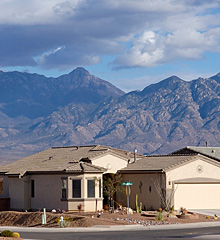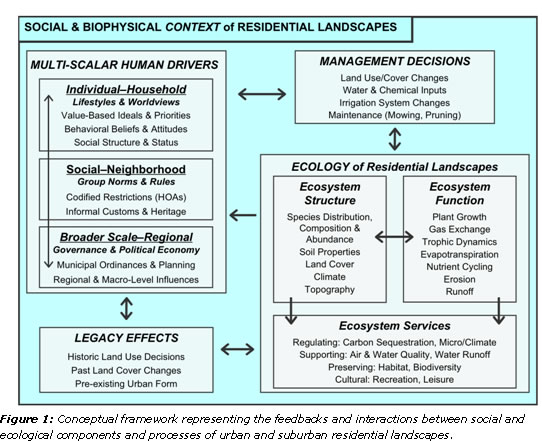
Intensively managed household yards are an important, yet understudied, feature of urban ecosystems. Grass now covers an area that amounts to the largest irrigated crop in the United States (Milesi et al. 2005), covering 10-16 million ha (Robbins et al. 2001) and contributing to high rates of water and fertilizer use. Little is known, however, about how homeowner decisions about residential landscape management impact biogeochemical cycling in soils and vegetation or what the drivers of these landscape management decisions are.
CAP LTER scientists Kelli Larson and Sharon Hall along with a team of graduate and undergraduate researchers have begun investigating residential landscapes in four neighborhoods in Phoenix, Arizona. These distinct neighborhoods, which capture variations in landscaping and a cross-section of household incomes, are co-located with Survey 200 and Phoenix Area Social Survey field sites, allowing the researchers to draw on existing rich data sets.
Their research delves into two pressing questions:
- What are the factors that drive residential landscape management decisions?
- How do landscape management practices affect ecological processes, specifically biogeochemistry?
To answer these questions, the research team has surveyed a random sample of households in each neighborhood. Each resident (total n=120) participating in the social survey provided information on residential landscape management practices including watering, pesticide and herbicide use, fertilization, and routine maintenance activities. The survey uses a modified value-belief-norm (VBN) model to determine the theoretical drivers of landscape management behavior, including personal values and environmental worldviews, beliefs about the consequences of yard management and responsibility for related environmental problems, and the social norms and expectations surrounding landscape management. Demographic data about the participating households as well as information about past land uses and irrigation methods have also been collected and are being used in the survey analysis.
The researchers have coupled the survey analyses with measurements of ecological variables in the front yards of all 120 homes. These variables include biological structure (groundcover amounts, plant community composition, distribution, and biovolume) and other visible characteristics of front yards. Moreover, to examine institutional structures, the research team has examined the Covenants, Codes and Restrictions (CCRs) in Homeowner Associations (HOAs) that govern landscaping across the Phoenix area. They have also conducted interviews with developers about their landscaping decisions and how these have changed over time.
Their conceptual approach and preliminary findings indicate that residential land management is driven by a myriad of decisions at the household, neighborhood, and regional scales (Figure 1). Overall, core personal values and environmental orientations did not have a strong effect on the preferences for yard types or actual yard types in the neighborhoods under study. However, there was a consistent pattern linking “eco-maintenance” (ease of care and environmental impact) priorities to landscaping preferences and practices, with some other types of values influencing still other yard choices. Residents who either maintained desert-like yards or preferred xeric yards prioritized easy yard maintenance and the environment in their decisions. Other findings underline the importance of landscaping legacies for understanding current landscape patterns and practices. Housing developers respond to the market, landscaping trends, and economic constraints when producing residential landscapes. The effects of these decisions may last long into the future and become institutionalized in HOA CCRs. The team’s analysis of a sample of CCRs for Phoenix-area subdivisions specifically indicated the potential for HOAs to dictate landscape maintenance and structure, topography and water management, and species composition with potentially significant impacts on the ecosystem services provided.
Future investigations under this project will examine a new, integrated approach to understanding multi-scalar drivers of residents’ yard management and ecological structure while focusing on the influence of values, beliefs, norms, and social-structural factors on residential land cover types, management practices (such as chemical and water applications), and yard quality. Additional work includes comparative analyses with other LTER sites, including the Baltimore Ecosystem Study (BES), Plum Island Ecosystems (PIE), and Florida Coastal Everglades (FCE) sites.
In sum, further interdisciplinary analysis of the human drivers of yard structure and management at multiple scales from households and neighborhoods to municipalities and broader regional forces will reveal the complex dynamics involved in the production of residential landscapes and their social and ecological consequences for current and future generations.

References
Milesi, C., S. W. Running, C. D. Elvidge, J.B. Dietz, B.T. Tuttle, and R.R. Nemani. 2005. Mapping and modeling the biogeochemical cycling of turf grasses in the United States. Environmental Management 36(3):426-438.
Robbins, P., A. Polderman, and T. Birkenholtz. 2001. Lawns and toxins: An ecology of the city. Cities 18(6):369-380.


